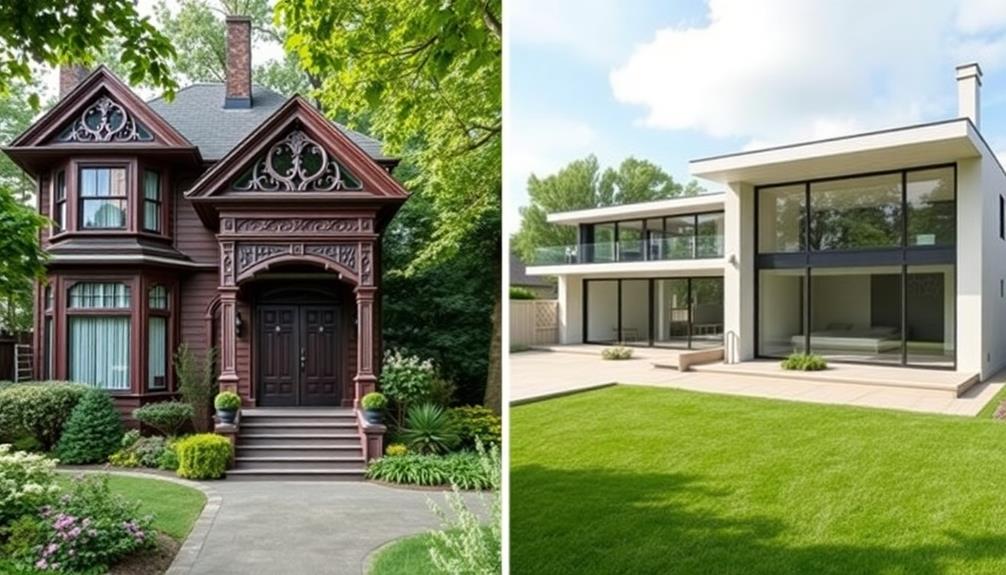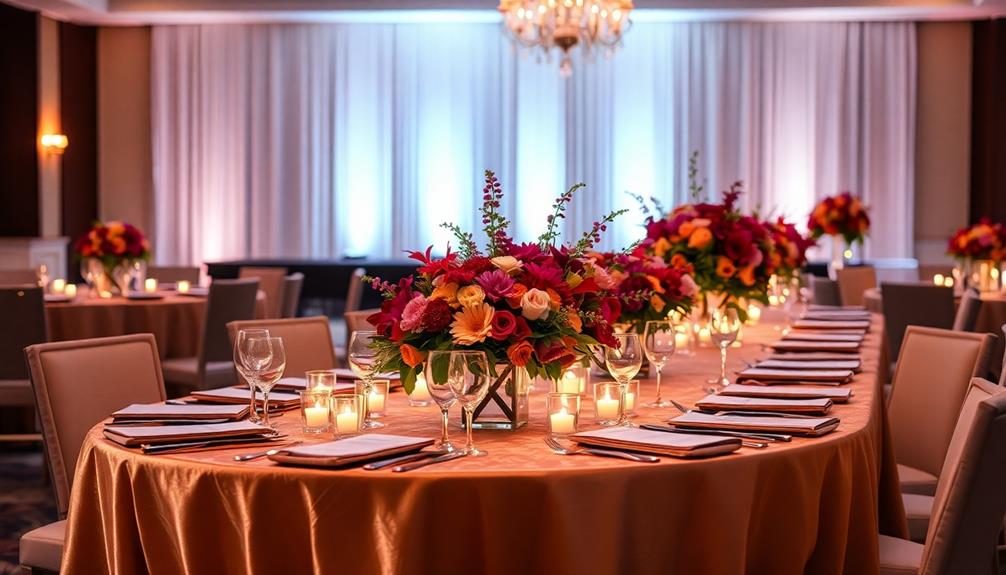When exploring the clash between classical and modern architecture, you'll notice distinct differences. Classical architecture features symmetry, ornate details, and traditional materials like stone and timber, exuding grandeur and timeless elegance. In contrast, modern architecture emphasizes minimalism with open spaces, clean lines, and innovative materials such as glass and steel. While classical designs reflect historical values of ancient civilizations, modern structures address contemporary needs and functionality. This juxtaposition shows how architecture evolves with culture and technology. If you think these contrasts are fascinating, there's plenty more to uncover about their impact on the architectural landscape.
Key Takeaways
- Classical architecture emphasizes symmetry and ornate details, while modern architecture focuses on simplicity and minimalism with functional aesthetics.
- Traditional materials like brick and stone dominate classical designs, whereas modern architecture utilizes innovative materials like glass, steel, and concrete.
- Historical context plays a significant role, with classical styles reflecting ancient values and modern designs responding to industrialization and urbanization.
- Functionality differs; modern architecture features open floor plans for adaptability, while classical designs often prioritize grand yet impractical entryways.
- Aesthetic appeal contrasts sharply, with classical structures evoking timeless grandeur and emotion, while modern designs prioritize practicality and clean lines.
Design Principles Comparison
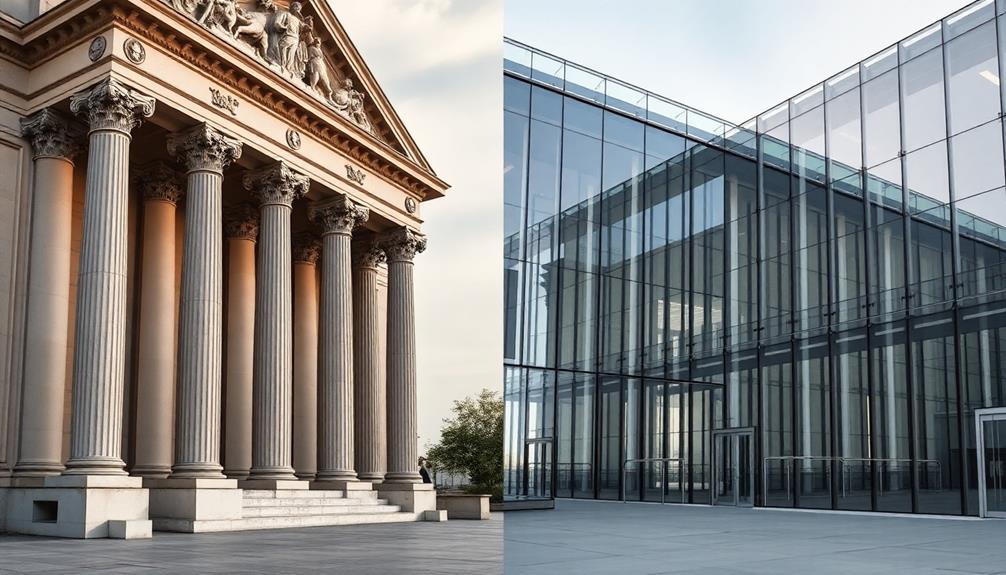
When comparing the design principles of classical and modern architecture, you'll notice a stark contrast in their approaches. Classical architecture emphasizes symmetry and proportion, creating a sense of order and grandeur. You'll find ornate details and elaborate ornamentation that reflect the craftsmanship of the time, showcasing the unique charm that blends beauty with practicality.
In contrast, modern architecture prioritizes simplicity and minimalism, focusing on clean lines and functional aesthetics, as observed in mood boards essential for visualizing design concepts. You might observe open spaces that enhance usability, allowing for a more flexible design.
While classical styles evoke a timeless elegance, modern designs embrace a more pragmatic view, responding to contemporary needs. Ultimately, these differing principles shape how you experience and interact with buildings, influencing everything from visual appeal to the building's intended purpose.
Materials and Their Impact
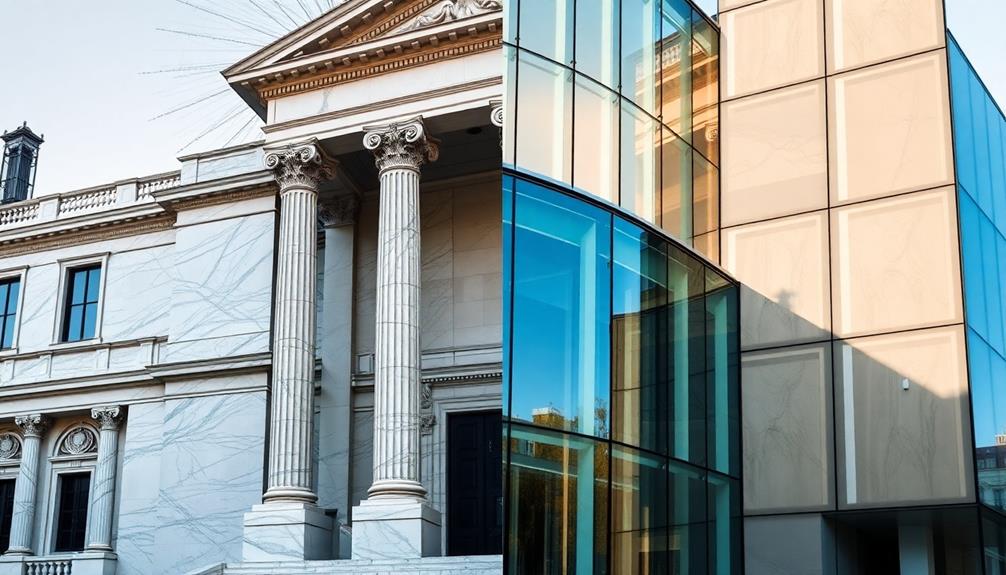
The choice of materials in architecture considerably shapes both aesthetic appeal and functionality. When you consider classical versus modern styles, the contrast becomes clear. Classical architecture often relies on timeless materials like brick, stone, and timber, emphasizing tradition and craftsmanship. In contrast, modern architecture favors innovative materials such as glass, steel, and concrete, promoting sleek lines and open spaces.
| Classical Materials | Modern Materials | Impact on Design |
|---|---|---|
| Brick | Glass | Enhanced light |
| Stone | Steel | Structural integrity |
| Timber | Concrete | Versatility |
These materials influence not just how buildings look but also how they function, reflecting the values and needs of their respective eras.
Historical Influences and Context

Throughout history, architecture has been deeply influenced by the cultural, social, and technological shifts of its time. You can see how these changes shaped both classical and modern styles.
For instance, technological innovations haven't only influenced construction methods but also impacted design aesthetics. Classical architecture often reflects the values of ancient civilizations, like Greece and Rome.
Modern architecture emerged as a response to the rapid industrialization and urbanization of the late 19th and early 20th centuries. The societal desire for order and hierarchy is evident in classical designs.
Cultural movements and technological advancements continually reshape architectural trends, leading to innovative expressions. Recognizing these historical influences helps you appreciate how each era's designs not only address aesthetics but also respond to the needs and values of their respective times.
Functionality in Architecture

Functionality in architecture serves as an essential bridge between form and use, ensuring that spaces cater to the needs of their occupants.
In modern architecture, you'll notice an emphasis on open floor plans that enhance usability and adapt to various lifestyles. This design approach prioritizes flexibility, allowing you to easily rearrange spaces according to your needs. Additionally, incorporating strategies for financial stability can further enhance the experience of a space by ensuring occupants can manage their resources effectively.
In contrast, classical architecture often focuses on grand entryways and ceremonial spaces, which may not always serve practical daily functions.
As you explore different styles, consider how modern designs incorporate innovative materials like glass and steel to create efficient work and living environments.
Ultimately, the functionality of a space plays an essential role in your overall experience and satisfaction with the architecture around you.
Aesthetic Differences and Appeal
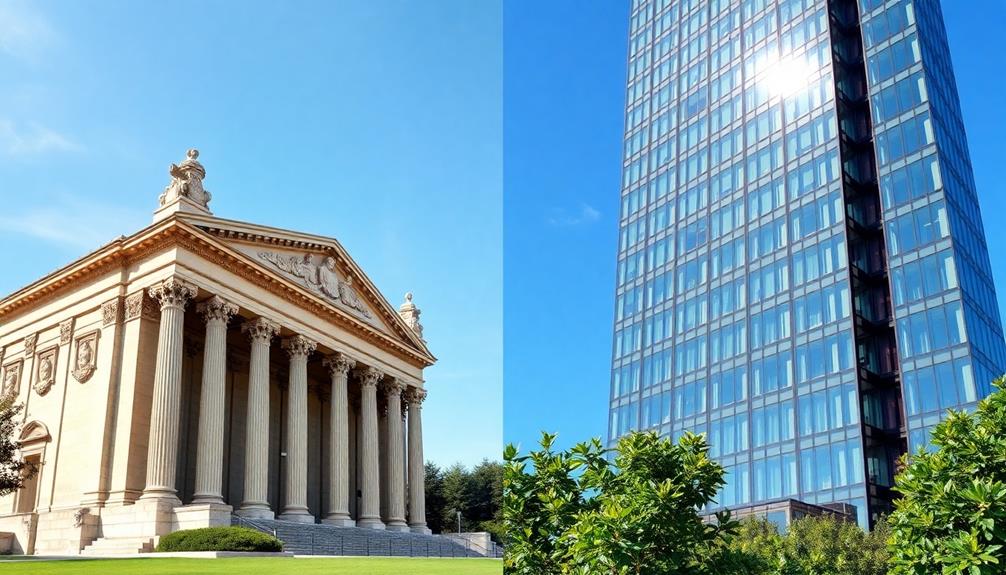
When you consider architecture, the aesthetic appeal can be as impactful as its functionality.
Classical and modern styles evoke different feelings and visuals, shaping your experience of space. Here's how they differ:
- Grandiosity vs. Minimalism: Classical architecture exudes grandeur, while modern designs often embrace simplicity.
- Ornamentation vs. Clean Lines: You'll notice ornate details in classical styles, contrasting sharply with the clean lines found in modern buildings.
- Timelessness vs. Innovation: Classical structures feel timeless and stately, while modern architecture showcases the latest materials and techniques.
- Emotional Resonance vs. Practicality: Classical designs inspire awe, whereas modern styles often prioritize functional aesthetics that adapt to your lifestyle.
These differences highlight how each era's aesthetic choices reflect its values and cultural influences.
Frequently Asked Questions
How Do Classical and Modern Styles Influence Contemporary Architecture?
You'll find that classical styles inspire grandeur and symmetry, while modern designs promote minimalism and functionality. Together, they shape contemporary architecture, blending historical richness with innovative techniques to meet today's aesthetic and practical demands. This fusion allows architects to push the boundaries of creativity, balancing the ornate complexities of the past with the streamlined elegance of the present. The debate often emerges as one of ‘infinite painter vs infinite design,’ where the artist’s expressive vision intertwines with the architectural need for purposeful structure. By merging these philosophies, contemporary architecture becomes a canvas where artistry and utility coexist harmoniously, shaping spaces that resonate both emotionally and functionally.
What Are Some Famous Examples of Classical and Modern Buildings?
Think of architecture as a storybook. You're captivated by the Parthenon's grandeur and the simplicity of the Villa Savoye. These famous buildings showcase how history and innovation shape the world around you.
How Do Architects Blend Classical and Modern Elements Today?
Architects today blend classical and modern elements by incorporating ornate details within minimalist frameworks. You'll see traditional materials paired with innovative designs, creating spaces that honor history while embracing contemporary functionality and aesthetics.
What Role Does Technology Play in Modern Architectural Design?
Imagine Da Vinci wielding a tablet instead of a brush; technology revolutionizes modern architecture. It streamlines design processes, enhances collaboration, and allows for innovative materials, creating spaces that adapt to your evolving needs and lifestyles.
Are There Hybrid Architectural Styles That Combine Classical and Modern Features?
Yes, you'll find hybrid architectural styles that blend classical and modern features. These designs often merge ornate details with minimalist elements, creating unique spaces that reflect both tradition and contemporary innovation in aesthetics and functionality.
Conclusion
As you navigate the fascinating clash of classical and modern architecture, you realize how these styles shape our environments and emotions. Did you know that over 60% of people feel more inspired in spaces that blend both styles? This statistic highlights the power of architecture to influence our well-being and creativity. Embracing the best of both worlds not only honors the past but also paves the way for innovative designs that resonate with today's needs and aspirations.



